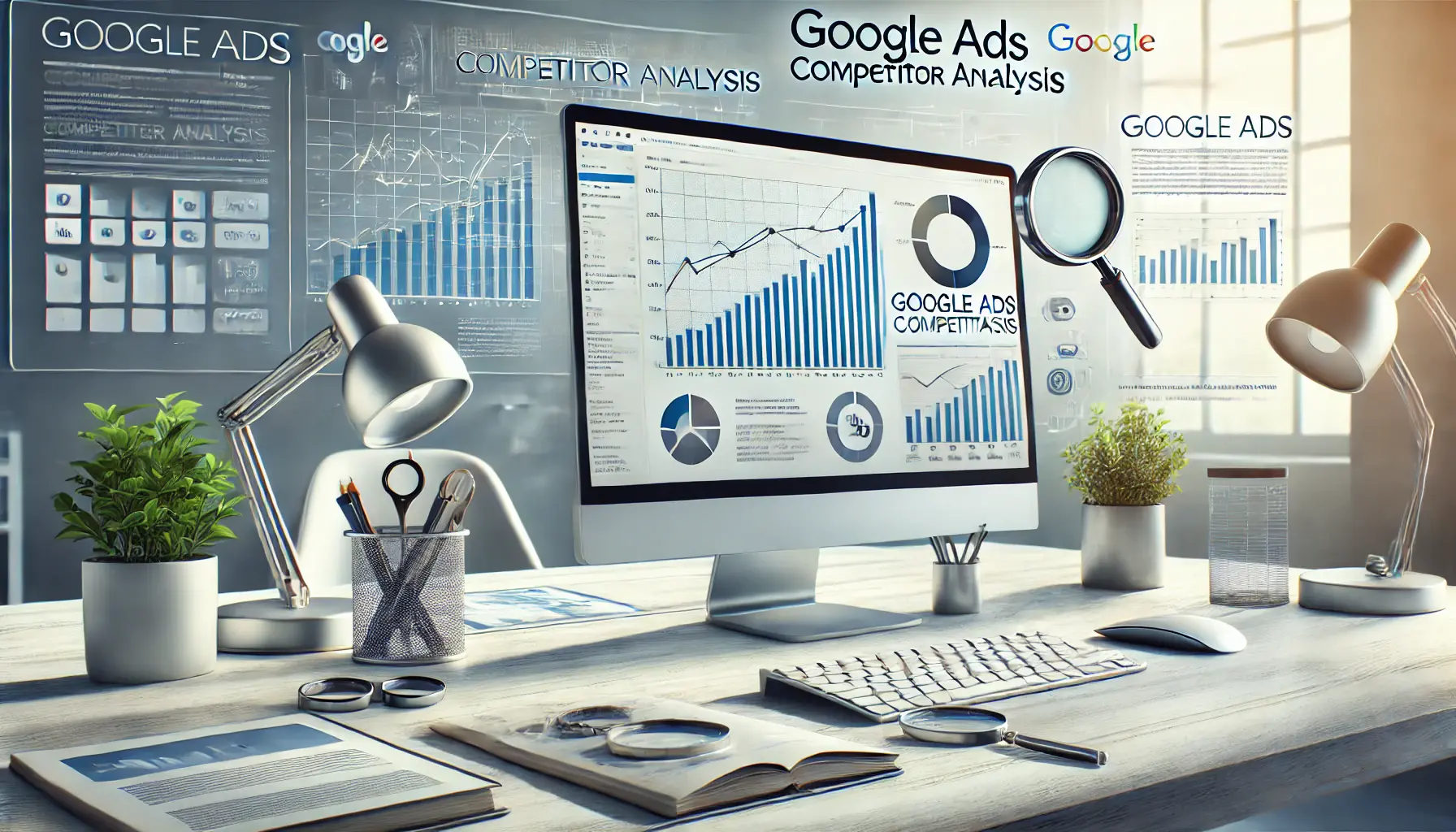Precise targeting in today’s competitive digital marketing world makes the difference between a successful ad campaign and wasted ad spend.
Google Ads boasts an array of features to help businesses fine-tune their campaigns and connect with their ideal customers at just the right moment.
But how can you leverage these tools?
The following article provides an in-depth overview of advanced campaign targeting for better efficiency and effectiveness, ensuring your ads are reaching the right people while you realize maximum return on investment.
Whether you are just starting out with Google Ads or are a seasoned marketer trying to fine-tune your approach, precision in campaign targeting is key.
Let’s start by understanding the foundation of campaign targeting in Google Ads and why it plays such a vital role in digital marketing success.
- Understanding Campaign Targeting in Google Ads
- Smarter Targeting: Upgraded Capabilities in Google Ads
- Advanced Targeting Settings for Maximization of Performance
- Best Practices for Campaign Targeting Optimization
- Future Trends in Google Ads Campaign Targeting
- Mastering Campaign Targeting for Success with Google Ads
- Commonly Asked Questions About Campaign Targeting in Google Ads
Understanding Campaign Targeting in Google Ads
Campaign targeting in Google Ads refers to the process of narrowing down your audience based on specific criteria such as demographicsStatistical data relating to the population and particular groups within it., interests, geographic locationA specific location or area where users reside, often used in targeting ads., and more.
By targeting the right audience, businesses can ensure that their ads will perform better and be served only to those most likely to engage or convert.
But why is targeting so important?
The digital advertising space has become extremely crowded; people are bombarded every day with hundreds of ads.
Without correct campaign targeting, your message can very easily get lost in the noise.
Precise targeting helps you stand out, capture attention, and, more importantly, reach the people who are most interested in what you offer.

Digital illustration of campaign targeting strategy, highlighting audience segmentation and precision in ad placement.
What is Campaign Targeting?
Essentially, campaign targeting in Google Ads enables advertisers to display their ads only to certain sets of users based on pre-defined characteristics.
These characteristics might involve age, gender, location, device usage, and even very specific behaviors such as prior interactions with your website or app.
Campaign targeting ensures your ads will be relevant to the users who will view them.
For instance, if you are an athletic gear business, you can target users who have shown interest in sports, fitness, or health-related content.
By doing so, you help your ads reach people most likely to purchase products from you rather than wasting your ad budget on an audience that’s too general and with less interest in your product.
This will not only raise your CTRClick-Through Rate, a metric that measures the percentage of people who clicked on an ad. and conversion rates but also ensure that your ads appear in front of people who are genuinely interested in your product or service.
By allocating your ad budget toward an audience with more targeted parameters, you will be able to lower ad spend without sacrificing your marketing goals.
In contrast, broad campaign targeting can result in low engagement rates, some pointless impressions, and a total waste of resources, as your ads would have been shown to users who have no interest in what you offer.
- Improves Engagement: With precise targeting, it is more likely that the right set of users will actually click on your ads.
- Grows Conversions: If the users are targeted appropriately, they have a higher chance of taking action—such as making a purchase, signing up for a service, or downloading an app.
- Saves Costs: By focusing your efforts on a smaller, more relevant audience, you see better results with less spend.
Targeting helps you reach the right people at the right time, improving both engagement and conversions.

High-tech visualization of smarter targeting with AI and machine learning capabilities in Google Ads.
Smarter Targeting: Upgraded Capabilities in Google Ads
Google Ads is constantly undergoing refinement, and updates that grant more specific campaign targeting are at the forefront.
These advancements are further enabled by the increased development of machine learningA type of artificial intelligence (AI) that enables computers to learn from data without being explicitly programmed. and artificial intelligence, which give marketers better ways to provide more personalized, relevant ads for targeted audiences.
These advanced targeting options mean that an enterprise can continue to be competitive within a noisy digital space and significantly improve the effectiveness of its campaigns.
Google offers various new and enhanced capabilities to help with effective campaign targeting: audience segmentation, rich demographic insight, AI-powered optimization, and many advanced bidding options that auto-adjust in real-time.
These enhancements empower marketers to reach the correct audience and ensure better return on ad spend (ROASReturn On Ad Spend, a marketing metric that measures the revenue generated for every dollar spent on advertising.) for their advertising investment.

AI and machine learning optimizing ad targeting by analyzing user behavior data.
Using Artificial Intelligence and Machine Learning in Targeting
The use of artificial intelligence and machine learning algorithms forms one of the biggest innovations in Google Ads.
These technologies analyze enormous amounts of data to predict users’ behaviors, helping advertisers understand who is likely to convert with their ads.
AI learns from user interactions over time and automatically adjusts your campaign targeting and bidding strategies in real-time to improve the chances of conversions.
This AI-powered optimization enables businesses to focus on users who are most likely to convert, thus reducing ad spend wastage.
Features such as Smart Bidding utilize machine learning to determine optimal bid values based on conversion data.
This ensures businesses extract more value from their campaigns without the hassle of manual settings adjustments.

Illustration of audience segmentation strategies, showcasing different user groups based on various criteria.
Audience Segmentation Strategies
Audience segmentation allows you to target users at different stages of the customer journey with more personalized ads.
For example, you can build custom audiences for users who visited your website and added items to their cart but did not complete the purchase.
Segmented audiences enable you to retarget them with specific offers, increasing the chances of conversion.
Additionally, audience expansion options allow for targeting new prospective customers who behave similarly or show similar interests to your existing audiences.
- Detailed Demographics: Target user-level demographics like household income, education, and parental status to create highly targeted ads.
- In-Market Audiences: Target users who are actively searching for services or products similar to yours.
- Affinity Audiences: Reach users based on their long-term interests and habits, such as gym-goers or tech enthusiasts.
- Custom Audiences: Create a tailored audience by combining the targeting options that best suit your needs, including keywords, apps used, or websites visited.
AI-powered optimization has revolutionized campaign targeting, offering real-time adjustments that increase ad performance.

A detailed visualization of advanced targeting settings for optimizing digital ad performance.
Advanced Targeting Settings for Maximization of Performance
Google Ads provides access to a wealth of advanced campaign targeting settings, each designed to fine-tune your campaigns for maximum output.
These settings enable businesses to go beyond basic demographic targeting and focus on user behaviors, interests, and interactions.
By leveraging these advanced options, your ads can reach the right audience at the right time, ensuring you maximize your return on ad spend (ROAS) and improve overall campaign effectiveness.
Some of the key advanced settings related to ad targeting include custom audiences, behavioral targeting, and ad scheduling.
These tools allow advertisers to tailor their campaigns with precision, ensuring the ads are relevant to each user’s specific needs and interests.

Visualization of custom audiences creation in Google Ads, highlighting personalized targeting based on specific audience characteristics.
Custom Audiences in Google Ads
Custom audiences allow advertisers to create highly personalized ad experiences based on a combination of user data, such as keywords they search for, apps they use, or websites they visit.
This feature allows businesses to build an audience from scratch by defining what their ideal customer base looks like.
For example, if you’re targeting users who show interest in a particular product category, custom audiences enable you to precisely target those users with highly relevant ads.
With custom audiences, you can also create Lookalike AudiencesA group of people who resemble your current customers, based on behaviors or interests. that target new users who resemble the traits or behaviors of your current customers.
This helps expand your reach while maintaining a high level of relevance, ensuring you’re connecting with users who are more likely to engage with your ads and convert.

Visualization of remarketing in Google Ads, focusing on retargeting users who have interacted with a brand.
Remarketing for Improved Campaigns
Remarketing is a powerful tool that allows businesses to target users who have already interacted with their brand but haven’t completed a desired action, such as making a purchase or signing up for a service.
By showing them relevant ads based on their previous interactions, you can encourage them to return and complete the conversion process.
For example, if a user visits your website, adds items to their cart but doesn’t complete the purchase, you can use remarketing to remind them of the items they left behind.
This increases the chances of conversion by keeping your brand top-of-mind and providing a gentle nudge to finalize the transaction.
- Custom Audiences: Create customized audiences based on behaviors, including keyword searches, app usage, and website visits.
- Lookalike Audiences: Find new users who act similarly to your existing customer base.
- Remarketing: Target users who have interacted with your brand but have not completed a conversion.
Leveraging custom audiences and ad scheduling ensures maximum ROI from your campaigns.
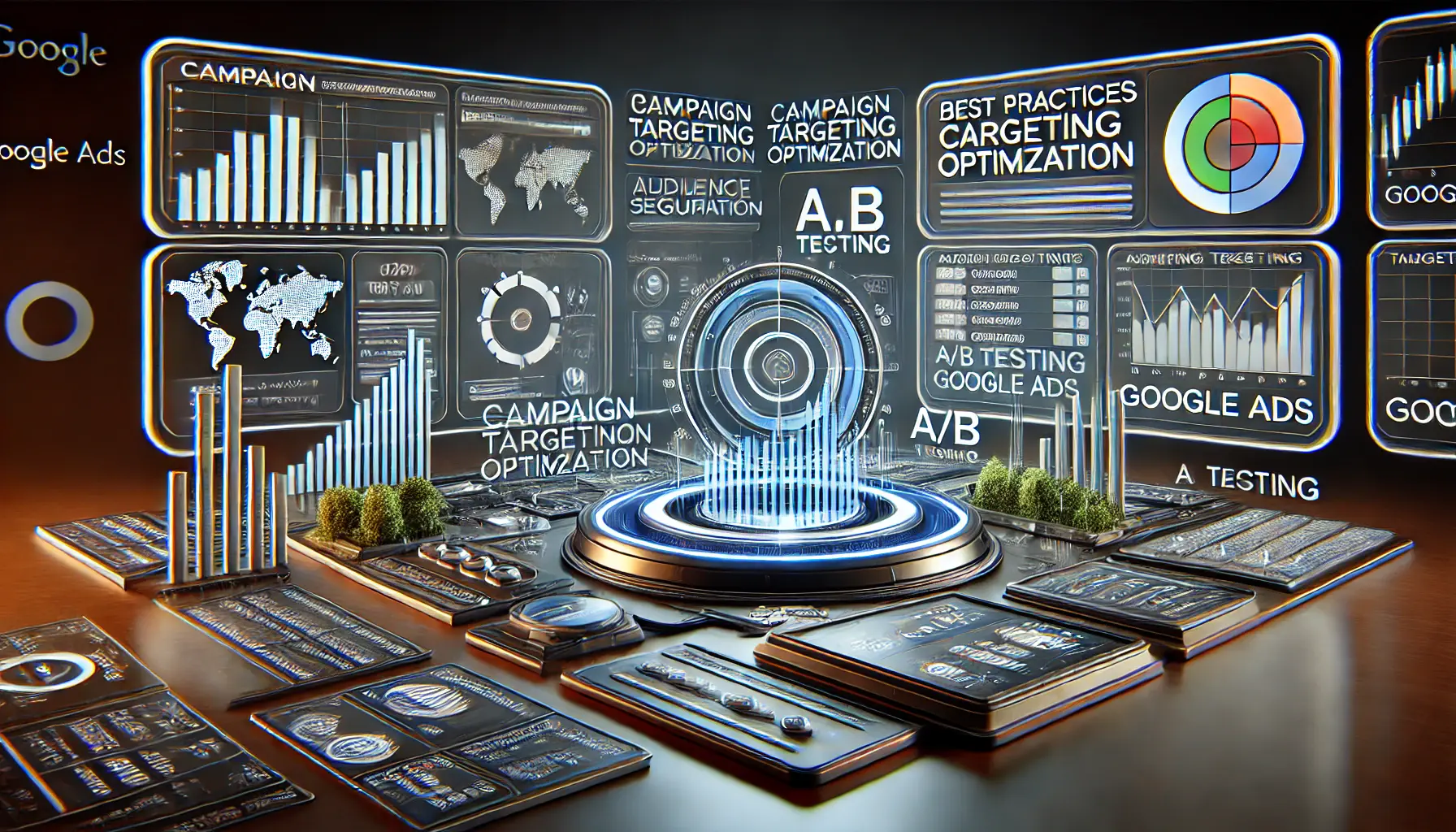
Visualization of best practices for optimizing campaign targeting in Google Ads, highlighting iterative testing and tracking.
Best Practices for Campaign Targeting Optimization
The optimization of campaign targeting in Google Ads plays a critical role in deriving the best performance from your efforts while ensuring a high return on investment (ROI).
Establishing best practices within your campaigns ensures you are fully leveraging the advanced functionality Google Ads offers, while continuously refining your strategy with data-driven insights.
Testing, tracking, and making necessary adjustments turn the optimization process into an ongoing cycle of improvement.
Key enablers for successful optimization include continuous testing and adjustment, conversion tracking, targeting data analysis, and campaign adjustments based on user behavior and market trends.
By incorporating these best practices, you can significantly enhance the efficiency and success of your Google Ads campaigns.
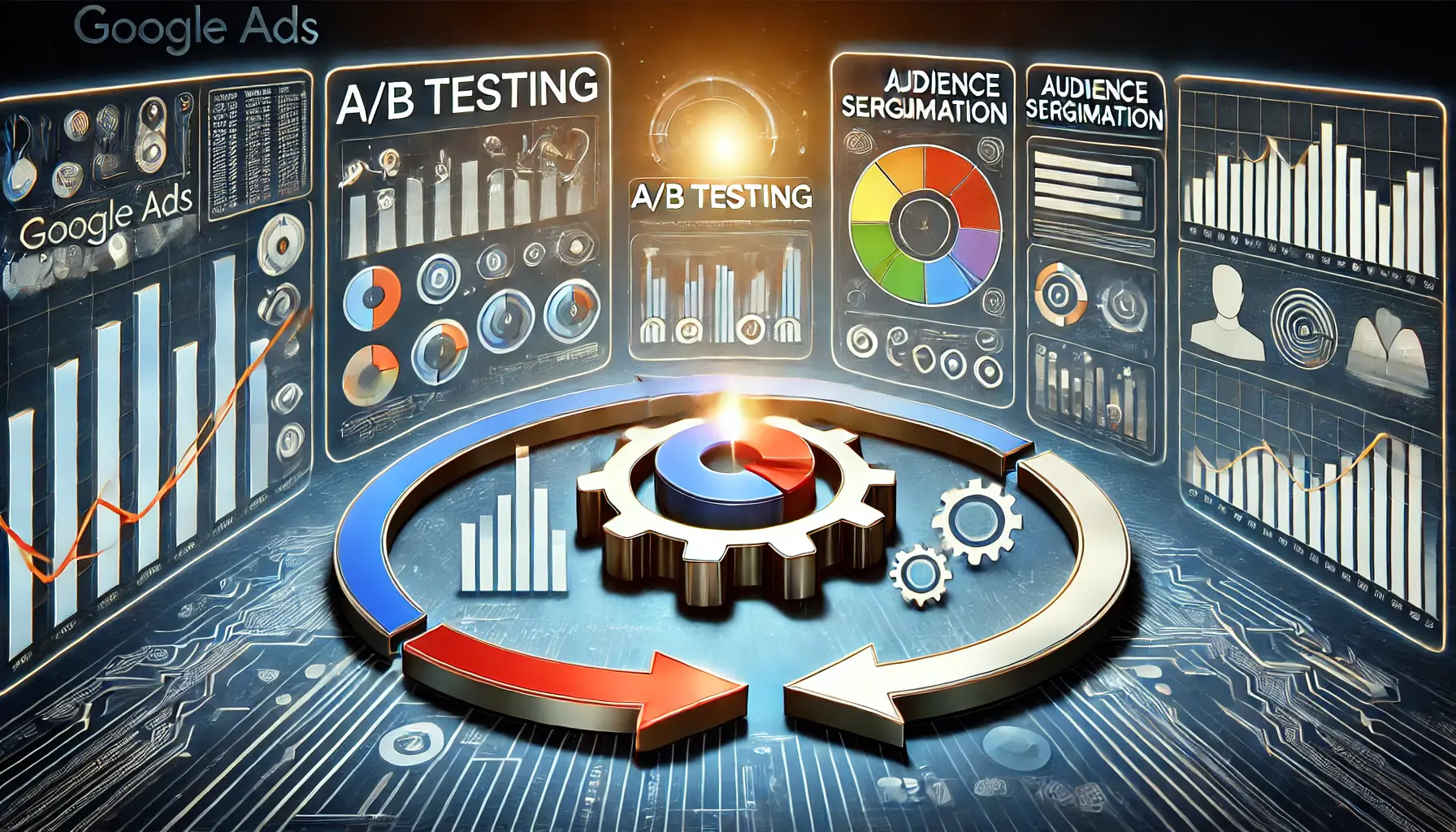
Visualization of continuous testing and adjustments in Google Ads, showcasing the iterative process of optimizing campaigns.
Continuous Testing and Adjustments
One of the most important aspects of optimizing your campaign targeting is continuous testing.
A/B testing different ad elements, such as copy, visuals, and targeting criteria, helps determine what resonates best with your audience.
Testing shouldn’t be a one-time activity but, rather, an ongoing strategy integrated into your overall campaign management processes.
You can test audience segments to identify which segments perform better for a particular offer.
By experimenting with variables like geographic location, age range, and interests, you can refine your targeting strategy to ensure your ads appear in the most relevant places.
Continuous optimization leads to improved click-through rates (CTR), conversions, and lower cost-per-click (CPCCost Per Click, the amount you pay each time a user clicks on your ad.).
Visualization of conversion tracking in Google Ads, focusing on tracking metrics like purchases and sign-ups.
Conversion Tracking in Use
Conversion tracking shows how well your campaign targeting is performing.
By tracking actions such as purchases, sign-ups, or downloads, you gain valuable insights into which targeting strategies are generating the most conversions.
This allows you to adjust your campaigns based on what works best.
Setting up conversion tracking within Google Ads also helps measure the ROI of specific keywords, audience segments, and even individual ads.
With this data, you can make informed decisions on how to reallocate your budget toward the most effective strategies.
- A/B Testing: Regularly test different ad elements to find what works best for your audience.
- Geographic Targeting: Experiment with different geographic locations to find your highest-value customers.
- Conversion Tracking: Use conversion data to continuously optimize your campaigns for better performance.
Regular testing and conversion tracking are critical for continuous optimization of campaign targeting.

Visualization of future trends in Google Ads targeting, featuring advanced AI and predictive analytics tools.
Future Trends in Google Ads Campaign Targeting
With technology still evolving, the future of campaign targeting in Google Ads is bound to become even more sophisticated and dynamic.
As AI, machine learning, and privacy regulations continue to develop, the stakes are raised for advertisers to stay ahead in their campaigns.
Understanding and adapting to these future trends is crucial for those who want to remain competitive in the dynamic digital landscape.
From AI-driven automation to cross-channel targeting, the future holds exciting possibilities for making your Google Ads campaigns more precise.
This will open up new opportunities for your business, while also ensuring that you keep up with changes in consumer behavior and rising concerns about privacy.

Visualization of evolving AI tools in targeting, showcasing the advancements in AI-driven targeting optimization.
Evolving AI Tools in Targeting
AI will continue to drive effective ad delivery with increasing integration into campaign targeting, powered by the predictive capabilities of user behavior and automation of many aspects of campaign management.
AI-driven features, such as predictive targeting and automated bidding, make it easier to reach the right users at the right time without much manual effort.
For example, AI-powered tools can now predict the exact time when users are most likely to engage with an ad, allowing businesses to schedule their campaigns for maximum impact.
Additionally, AI will enhance ad copy and creatives to cater to user preferences, improving campaign performance without the need for constant manual updates.

Visualization of privacy changes and their impact on targeting, highlighting the balance between privacy and effective ad targeting.
Privacy Changes and Their Impact on Targeting
With ever-evolving privacy legislation and regulations, advertisers will need to adapt their campaign targeting strategies to comply with new laws and changing user expectations.
Privacy-centric updates—like the elimination of third-party cookies—will significantly impact how businesses track and target users.
In response, Google Ads is working on new solutions, such as Federated Learning of Cohorts (FLoC) and the Privacy Sandbox, to provide effective targeting options while maintaining user privacy.
These privacy-first initiatives aim to strike a balance between personalized advertising and consumer data protection.
As these changes take effect, businesses will need to rely on first-party data, contextual targeting, and AI-driven insights to maintain precision in their targeting while respecting user privacy.
- AI-Powered Automation: AI tools will continue to refine campaign targeting by automating key aspects of ad management, improving precision.
- Privacy-First Targeting: New privacy regulations will push advertisers to find new ways of targeting users, relying more on first-party data and privacy-safe solutions.
- Cross-Channel Targeting: Increased integration across different platforms and devices will provide a more holistic approach to digital advertising.
AI and privacy regulations will drive future advancements in campaign targeting.
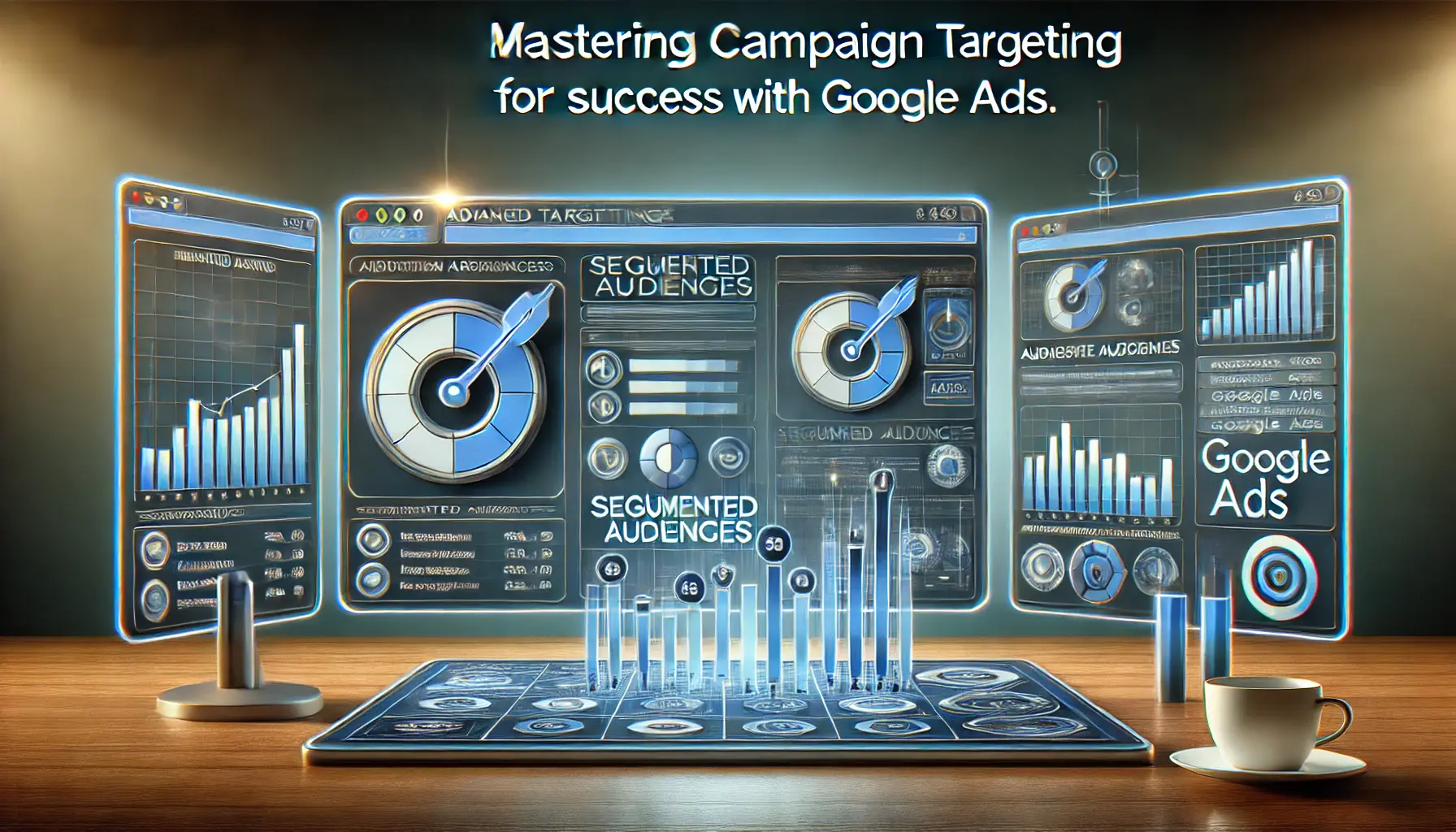
Visualization of mastering campaign targeting for success, focusing on precision and strategy in Google Ads.
Mastering Campaign Targeting for Success with Google Ads
Effective campaign targeting can be crucial for businesses that want to achieve maximum success with Google Ads in the ever-evolving digital marketing space.
Throughout this article, we have explored advanced tools and strategies to help fine-tune your targeting and enhance the performance of your ad campaigns.
From understanding the importance of precision targeting to using AI-powered tools and adapting to changes in privacy regulations, the future of Google Ads offers plenty of opportunities for businesses that stay ahead of the curve.
Key strategies such as continuous testing, AI automation, and adopting privacy-friendly solutions ensure that your ads reach the right audiences at the perfect time.
By leveraging these approaches, businesses can significantly improve the effectiveness of their campaigns.

Visualization of key features in digital campaign targeting, highlighting important tools and metrics for success.
Features to Key In:
- Advanced Targeting Features: Fine-tune your targeting using AI-powered tools, custom audiences, or detailed demographics to achieve better outcomes.
- Continuous Optimization: Regularly test your campaigns and make adjustments to maintain responsiveness to changing market and user behaviors.
- Privacy-First Approach: Stay compliant with evolving privacy regulations while maintaining precision through first-party data and contextual targeting.

Visualization of staying competitive in the digital landscape, with advanced tools for optimizing ad performance and strategy.
Looking Ahead: Staying Competitive in the Digital Landscape
With continued advancements in AI, machine learning, and privacy regulations, your campaign targeting strategy needs to evolve to stay competitive.
The ability to predict user behavior, automate ad delivery, and respond to privacy concerns will be key to future success.
Marketers who stay informed and agile will be best positioned to take advantage of new opportunities while avoiding the pitfalls of outdated strategies.
Businesses can unlock the full potential of Google Ads by following best practices and leveraging the most advanced tools available.
With precise campaign targeting, you can connect with your audience more effectively, increase engagement rates, and, most importantly, drive better results for your business.
By mastering the art of precise campaign targeting, businesses can significantly improve their ad performance and ROI.
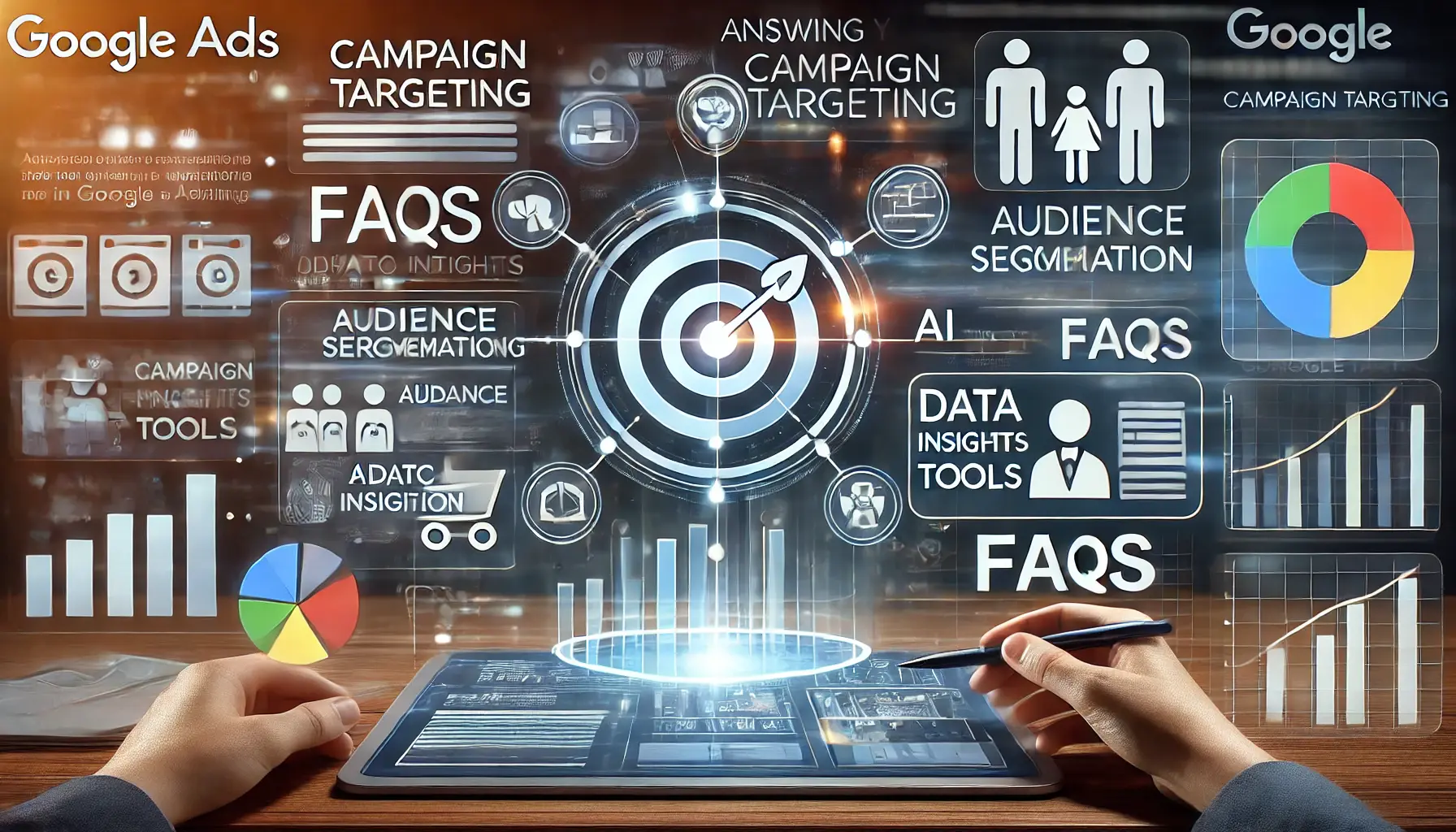
Visualization of common questions about campaign targeting in Google Ads, featuring tools for audience segmentation and performance tracking.
Your campaigns can be managed by an agency specialized in Google Ads, check out our service page.
Commonly Asked Questions About Campaign Targeting in Google Ads
In this section, you’ll find some of the most frequently asked questions about campaign targeting in Google Ads, along with concise answers to help you gain more knowledge on improving ad performance.
Campaign targeting in Google Ads means narrowing your audience to deliver ads to relevant users based on specific characteristics such as demographics, interests, location, and behaviors.
AI automates key aspects of targeting in Google Ads, using machine learning to predict user behavior and optimize campaigns in real time, ensuring that ads reach the right users at the right time.
Custom audiences allow advertisers to create targeted audiences based on user search queries, app usage, or website browsing behavior, ensuring that ads are served to users more likely to engage with them.
Continuous testing helps identify which audiences, ad creative, and campaign targeting strategies work best, allowing for ongoing optimization to improve click-through and conversion rates.


